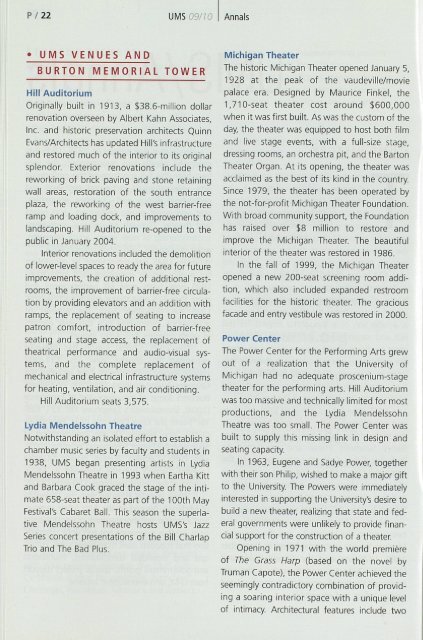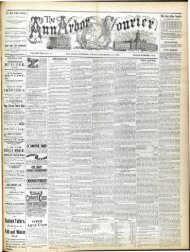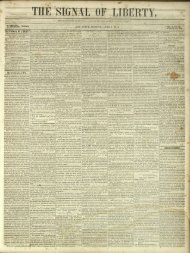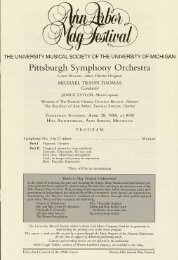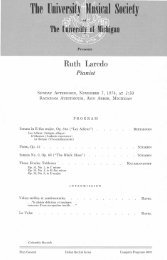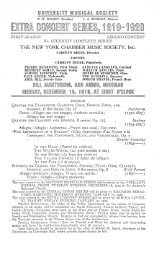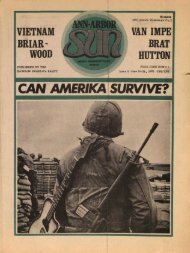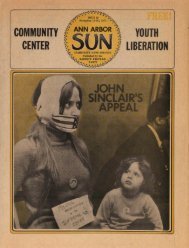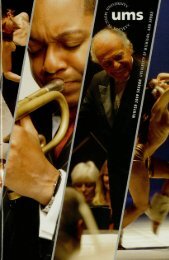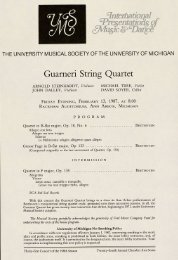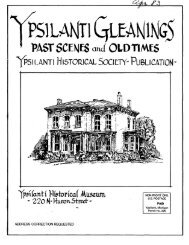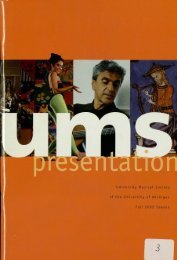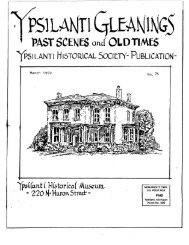university musical society - Ann Arbor District Library
university musical society - Ann Arbor District Library
university musical society - Ann Arbor District Library
You also want an ePaper? Increase the reach of your titles
YUMPU automatically turns print PDFs into web optimized ePapers that Google loves.
P/22 UMS 097 70 <strong>Ann</strong>als<br />
• UMS VENUES AND<br />
BURTON MEMORIAL TOWER<br />
Hill Auditorium<br />
Originally built in 1913, a $38.6-million dollar<br />
renovation overseen by Albert Kahn Associates,<br />
Inc. and historic preservation architects Quinn<br />
Evans/Architects has updated Hill's infrastructure<br />
and restored much of the interior to its original<br />
splendor. Exterior renovations include the<br />
reworking of brick paving and stone retaining<br />
wall areas, restoration of the south entrance<br />
plaza, the reworking of the west barrier-free<br />
ramp and loading dock, and improvements to<br />
landscaping. Hill Auditorium re-opened to the<br />
public in January 2004.<br />
Interior renovations included the demolition<br />
of lower-level spaces to ready the area for future<br />
improvements, the creation of additional rest-<br />
rooms, the improvement of barrier-free circula<br />
tion by providing elevators and an addition with<br />
ramps, the replacement of seating to increase<br />
patron comfort, introduction of barrier-free<br />
seating and stage access, the replacement of<br />
theatrical performance and audio-visual sys<br />
tems, and the complete replacement of<br />
mechanical and electrical infrastructure systems<br />
for heating, ventilation, and air conditioning.<br />
Hill Auditorium seats 3,575.<br />
Lydia Mendelssohn Theatre<br />
Notwithstanding an isolated effort to establish a<br />
chamber music series by faculty and students in<br />
1938, UMS began presenting artists in Lydia<br />
Mendelssohn Theatre in 1993 when Eartha Kitt<br />
and Barbara Cook graced the stage of the inti<br />
mate 658-seat theater as part of the 100th May<br />
Festival's Cabaret Ball. This season the superla<br />
tive Mendelssohn Theatre hosts UMS's Jazz<br />
Series concert presentations of the Bill Charlap<br />
Trio and The Bad Plus.<br />
Michigan Theater<br />
The historic Michigan Theater opened January 5,<br />
1928 at the peak of the vaudeville/movie<br />
palace era. Designed by Maurice Finkel, the<br />
1,710-seat theater cost around $600,000<br />
when it was first built. As was the custom of the<br />
day, the theater was equipped to host both film<br />
and live stage events, with a full-size stage,<br />
dressing rooms, an orchestra pit, and the Barton<br />
Theater Organ. At its opening, the theater was<br />
acclaimed as the best of its kind in the country.<br />
Since 1979, the theater has been operated by<br />
the not-for-profit Michigan Theater Foundation.<br />
With broad community support, the Foundation<br />
has raised over $8 million to restore and<br />
improve the Michigan Theater. The beautiful<br />
interior of the theater was restored in 1986.<br />
In the fall of 1999, the Michigan Theater<br />
opened a new 200-seat screening room addi<br />
tion, which also included expanded restroom<br />
facilities for the historic theater. The gracious<br />
facade and entry vestibule was restored in 2000.<br />
Power Center<br />
The Power Center for the Performing Arts grew<br />
out of a realization that the University of<br />
Michigan had no adequate proscenium-stage<br />
theater for the performing arts. Hill Auditorium<br />
was too massive and technically limited for most<br />
productions, and the Lydia Mendelssohn<br />
Theatre was too small. The Power Center was<br />
built to supply this missing link in design and<br />
seating capacity.<br />
In 1963, Eugene and Sadye Power, together<br />
with their son Philip, wished to make a major gift<br />
to the University. The Powers were immediately<br />
interested in supporting the University's desire to<br />
build a new theater, realizing that state and fed<br />
eral governments were unlikely to provide finan<br />
cial support for the construction of a theater.<br />
Opening in 1971 with the world premiere<br />
of The Grass Harp (based on the novel by<br />
Truman Capote), the Power Center achieved the<br />
seemingly contradictory combination of provid<br />
ing a soaring interior space with a unique level<br />
of intimacy. Architectural features include two


